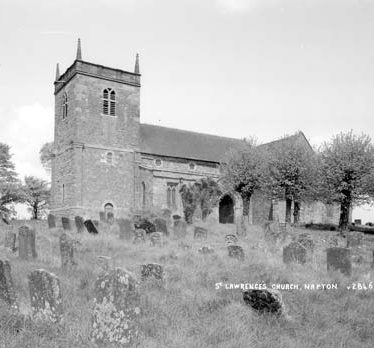Church of St Lawrence, Napton on the Hill
The Church of St Lawrence was originally built during the Medieval period. It was largely restored during the Post Medieval period and the tower added during the Imperial period. The church is situated 100m north of The Butts, Napton on the Hill.
1 12th century church probably consisted of chancel, nave, N and S transepts, nave and W tower. It was rebuilt 13th century, when the aisles were added, and at a later date, probably 17th century, a vestry and porch were built. The tower has been completely rebuilt in recent times. There was a priest at Napton in 1086.
4 Photographed in 1979.
5 A multi-service trench was laid along the pathway route in 1998. Archaeological observations showed no archaeological features. Locals claim that the graveyard was bulldozed in the 1950s to make room for new burials.
6 The vestry was erected shortly before 1844 with a reused 14th century window in its north side. The vestry’s window is similar to two of the windows on the south ailse either side of the south porch. The window must have come from elsewhere in the church possibly from the north ailse, before the projecting window was inserted. The evaluation trenches did not recover any structural remains associated with any earlier parts of the church. They did however, reveal a number of undated burials. The medieval pottery found within the trenches is likely to derive from the surrounding medieval settlement.
7 81 skeletons, in addition to a large number of disarticulated remains, were discovered on the northern side of the church, part of the site lying underneath the 19th century vestry that was previously demolished. Possible dates for the burials vary from between the 12th century to the mid-19th century, yet all were aligned with the church so are not likely to pre-date it. Additionally a ditch was sealed beneath the remains containing Roman pottery, indicating at least a medieval date if not earlier. Medieval pottery was also uncovered in the graveyard soil but most likely to be residual.
- For the sources of these notes, see the
- Timetrail record
- produced by the Historic Environment Record.










Comments
There are various legends and beliefs about it. According to one legend the church was meant to have been built at a lower level on the village green. Every night though the building materials were carried to the top of the hill by supernatural beings. So the builders gave in and built it there.
Anyone said to run around it three times at midnight will see the Devil!
Various people have claimed to have seen ghosts in and around it.
There is said to be a tunnel linking it to the now demolished vicarage.
Sources: “Haunted Warwickshire” by Meg Elizabeth Atkins
“Folklore of Warwickshire” by Roy Palmer
Add a comment about this page